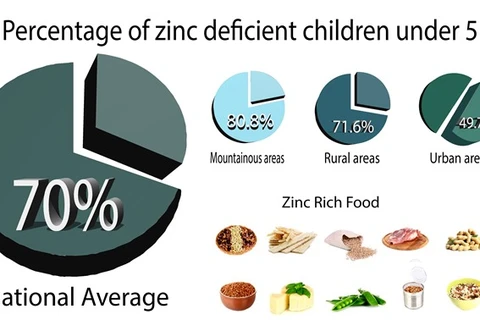Hanoi (VNA) – Vietnam has taken different solutions to prevent micronutrient deficiency, which is relatively common in the country, especially in rural and mountainous areas.
Deficiency of iodine, vitamin A, iron and zinc is the main cause of common micronutrient deficiency diseases in Vietnam, according to the National Institute of Nutrition (NIN).
A survey conducted by the National Hospital of Endocrinology shows that from 2010 to 2015, 9.8 percent of children aged between 8-10 were afflicted with goiter while only about 60 percent of families used qualified iodised salt. These were the lowest rates in the last 10 years.
The NIN said iodine is a very important micronutrient, and a shortage of iodine will lead to major consequences which in turn affect public health and socio-economic development.
In another survey conducted in 2014 and 2015 by the NIN, the rate of preclinical vitamin A deficiency among under-5 children was 13 percent and the rate of vitamin A in breast milk was only 34.8 percent. These rates were unchanged from another NIN census in 2010
The World Health Organisation (WHO) listed Vietnam among 19 countries with serious preclinical vitamin A deficiency, more than 10 percent among under-5 children.
Meanwhile, the rate of blood deficiency was 32.8 percent among pregnant women, 25.5 percent among the non-pregnant, and 27.8 percent among under-5 children. These rates were higher in mountainous and rural areas and lower in cities, according to an NIN survey in 2014 and 2015.
Zinc deficiency was also rampant, with 80.3 percent pregnant women, 63.6 percent non-pregnant, and 69.4 percent under-5 children afflicted. According to the International Zinc Nutrition Consultative Group, zinc deficiency is a public health concern when the rate is more than 20 percent.
The NIN attributed the high micronutrient deficiency to a poor diet. Facing this fact, many solutions have been devised.
The Vietnamese Government approved a national strategy on nutrition, a national action plan on nutrition, a decree stipulating food fortification and a blueprint for improving the physical strength and height of Vietnamese people.
The country aims to reduce the rates of stunted children to below 21.5 percent and of children with preclinical vitamin A deficiency to below 8 percent by 2020. Meanwhile, the rates of pregnant women and children with blood deficiency are hoped to be cut down to below 23 percent and 15 percent, respectively.
The strategy for micronutrient deficiency prevention has combined different solutions such as taking micronutrient supplements, food fortification and diet diversification. While taking supplements quickly deals with micronutrient deficiency, food fortification and diet diversification is a long-term and sustainable solution.
As a result, nearly 1 million under-5 children have reportedly seen their vitamin A deficiency improve each year thanks to the biannual provision of vitamin A supplements for children between 6 and 36 months old nationwide and for those between 37 and 60 months old in 22 disadvantaged provinces.
The provision of vitamin A for children and post-partum mothers has become an annual activity in more than 11,000 communes across the country.-VNA
VNA

























